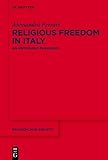Religious Freedom in Italy : An Impossible Paradigm? / Alessandro Ferrari.
Material type: TextSeries: Religion and Society ; 88Publisher: Berlin ; Boston : De Gruyter, [2023]Description: 1 online resource (VII, 201 p.)Content type:
TextSeries: Religion and Society ; 88Publisher: Berlin ; Boston : De Gruyter, [2023]Description: 1 online resource (VII, 201 p.)Content type: - 9783110743579
- 9783110743715
- 9783110743678
- 323.44/20945 23/eng/20240228
- BR872 .F4713 2024
- online - DeGruyter
- Issued also in print.
| Item type | Current library | Call number | URL | Status | Notes | Barcode | |
|---|---|---|---|---|---|---|---|
 eBook
eBook
|
Biblioteca "Angelicum" Pont. Univ. S.Tommaso d'Aquino Nuvola online | online - DeGruyter (Browse shelf(Opens below)) | Online access | Not for loan (Accesso limitato) | Accesso per gli utenti autorizzati / Access for authorized users | (dgr)9783110743678 |
Frontmatter -- Contents -- Introductory note -- 1 The right to religious freedom in the liberal era: from tolerance to freedom -- 2 The Conciliazione: fascism and its ecclesiastical policy -- 3 The right to religious freedom in the republican Constitution -- 4 The right to religious freedom: from text to action -- 5 The Villa Madama Accords of 1984: a new right to religious freedom for the Catholic Church -- 6 Beyond the Catholic Church: the era of pluralism and agreements -- 7 The Italian model faces change: policy shortcomings -- 8 Constitutional judges and the pyramid of religions: the difficulty of procedure without politics -- 9 The right to religious freedom of a nation-state: the ‘Catholic invariant’ in a changing society -- Epilogue The Italian right to religious freedom, specificity, and secularisation in the Euro-Mediterranean area -- Bibliography -- Index
restricted access online access with authorization star
http://purl.org/coar/access_right/c_16ec
Italy, seat of the Pope and Vatican City, has a long and difficult relationship with religious freedom. Often identified as a Catholic nation par excellence, Italy owes its unification to a political class that advocated the separation of Church and State. Home of the Concordat, contemporary Italy recognises a peculiar notion of legal secularism (laicità) as the supreme principle of its constitutional order. Through the glasses of law, tracing the history of the right to religious freedom from the Unification to the present day, the nine chapters of the book allow an insight on paradoxes and contradictions of a complex system made of unresolved stratifications where a strong constitutional recognition of religious freedom is accompanied by a weak legislative protection of religious pluralism and, at the same time, a vigorous religious agency in the public space. Religious freedom in Italy offers an interpretation of a model of religious freedom that is not only a paradigm for many European experiences but also a possible interpretative parameter to better understand the dynamics of religious freedom between the two shores of the Mediterranean.
Issued also in print.
Mode of access: Internet via World Wide Web.
In English.
Description based on online resource; title from PDF title page (publisher's Web site, viewed 06. Mrz 2024)


